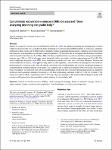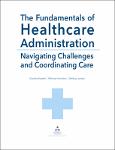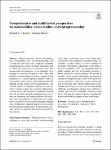Search
Author
- Marina, Dabić (3)
- Christa, Sys (2)
- Domingo, Ribeiro-Soriano (2)
- Gittell, Ross (2)
- next >
Subject
- kinh tế (26)
- Economics (12)
- Management science (7)
- Development Economics (6)
- next >
Date issued
- 2020 - 2023 (306)
- 2010 - 2019 (47)
- 2009 - 2009 (1)
Has File(s)
- true (354)
Search Results
Land systems combine land use and land cover, considering that their changes have important consequences for the local environment and human well-being and are pervasive factors of regional and global environmental change. More specifically, land consumption (LC), due to the occupation of originally agricultural, natural, or semi-natural areas, implies a progressive loss of key environmental resources and ecosystem services (ESs), reducing the individual well-being. Furthermore, policy makers need data on the benefits of public goods in monetary terms to support well-being-oriented decision-making. This work seeks to demonstrate that life satisfaction approach (LSA) can be applied to a practical assessment goal with the intention to give a monetary value to the LC and consequently t... |
Innovative enterprises may undertake innovation activity in the form of research and development (R&D) or the acquisition of already developed technology (imitative innovation). Both types of innovation may influence economic growth or catching-up processes in different ways. Therefore, in the research presented, various types of innovation activity are analysed based on Community Innovation Survey data. The question is how the regional environment, characterised based on the data on intangible assets, affects R&D activity and the acquisition of machinery and software. The analysis was conducted for the years 2004–2014 in 16 Polish regions. Intangible assets were measured using the intellectual capital index. Panel data econometric models were applied to test the relations between v... |
Inspired by a paper by Teseletso and Adachi (Miner Econ 8(10):21, 2021), the hypothesis regarding the declining grade of mined copper ore and its possible use as a guide to the future of ultimate recoverable resources (URRs) is tested. As a time axis, cumulative production is taken. Grades can be either grade of cumulative tonnage or annual production grade. Correlation can be linear (grade and tonnage) or semi-logarithmic (grade linear, tonnage logarithmic). We first show that the assumption that the highest correlation is the best guide to the future may be a fallacy. This is the linear correlation between grades of cumulative tonnage and cumulative tonnages since 1959, i.e., 85% of all copper mined historically with a near-perfect correlation approaching one (R2 = 0.97). This lea... |
This book is written for those interested in acquiring a thorough knowledge base relative to the intricacies of the organizational theories, customs, and insights significant to the management of health service organizations. It examines the foundational aspects of leadership and management as they relate to establishing and maintaining the principles and practices within healthcare organizations. The book opens with a discussion on the differences between health, healthcare, and health care while providing an overview of healthcare management and organizational trends. It culminates in discussions of leadership, management, motivation, organizational behavior, and management thinking. Additionally, it discusses topics of information technology, teamwork, health disparities, organiz... |
While practitioners discuss the phenomena of sustainability, cities, and entrepreneurship, such as living labs and smart cities, alongside sustainable entrepreneurial ecosystems at length, researchers tend to reduce the complexity by considering these phenomena from the perspective of one discipline or by merging two research disciplines at best. This study intends to provide guidance on what is required for the emergence of a transdisciplinary research stream of sustainability, urban studies, and entrepreneurship. By applying design science involving practitioners and scientific experts, we designed a relevant and rigorous future research agenda that considered phenomena, research design, and theoretical foundations. Starting from the basis that sustainable entrepreneurial ecosyste... |
Italian governments have frequently chosen tax amnesties or concessions, with the twofold purpose of creating new budget resources and cancelling irredeemable debts. Such course of action constitutes a “shortcut” policy in terms of fighting tax evasion, which is a matter less popular among voters and more demanding in terms of efficiency and political continuity. This paper investigates the effects of the 2016–2019 tax concession, bringing empirical evidence based on the car tax paid to the Tuscany Region. The car tax is the main source of regional fiscal autonomy in Italy. In terms of revenue recovery, we found a net amount of only 1.6% of the unpaid taxes accrued. A difference-in-difference (DiD) analysis of the effects on compliance showed that those who took advantage of the tax... |
Two-thirds of all businesses worldwide are family firms. For these family firms, absorptive capacity (AC) is key to acquiring, assimilating, transforming, and exploiting new, external knowledge for purposes of value creation. In this study, we conduct a literature review to obtain an overview of the existing research on AC in family firms. Drawing on 27 articles, we show that because of the family members’ induced influence on the family firm, the findings from previous studies based on non-family businesses cannot be applied to family businesses. In fact, we demonstrate that this influence can even create ambiguous effects on the integration of AC into the firm. |
Enterprise risk management (ERM) systems lessen the probability of risks harming a firm’s reputation for a number of reasons. First, a high-quality ERM system makes it less likely a firm will suffer a risk-based reputational crisis. Second, ERM systems help companies to behave more responsibly towards all stakeholders, thereby ensuring firms meet stakeholders’ expectations. Third, when a crisis stemming from an uncontrollable risk occurs, a high-quality ERM system helps to reduce the negative impact on reputation because stakeholders will not attribute guilt to a firm which has acted responsibly in its risk management. In this research, we explore the link between corporate reputation and ERM systems together with the role played by corporate social responsibility (CSR) performance ... |
The uniqueness of human labour is at question in times of smart technologies. As computing power and data available increases, the discussion on technological unemployment reawakens. Prominently, Frey and Osborne (Technol Forecast Soc Change 114:254–280, 2017) estimated that half of US employment must be considered exposed to computerization within the next 20 years; followed by a series of papers expanding the research with information on heterogeneous job-specific tasks within the same jobs diminishing digitization potentials to only smaller fractions of workers at high risk. |
Due to the war in Ukraine, the European Commission has released its “Save Gas for a Safe Winter” plan, communicating the goal of reducing gas consumption in the electricity sector, among others. In this paper, the gas consumption in the electricity sector is picked up and the well-established concept of demand response is brought into alignment with the consumption of gas in the electricity sector, leading to the concept of gas-to-power demand response. Two proposed programs based on this concept are then applied in a production planning approach that shows how companies could proactively contribute to easing the tense situation in Europe, particularly in Germany, especially using methods such as scheduling and/or lot-sizing. This article is intended to serve as a basis for further ... |










